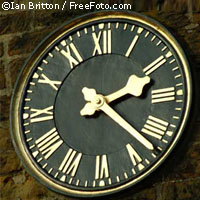Pulse of bright light affects body's internal clock, study shows
Exposure to brief periods of extremely bright light a few hours before sleeping is enough to synchronise the body's internal clock to the required day length, according to new research. The work, which was partly funded by the EU's Sixth Framework Programme (FP6) through the EUCLOCK project, appeared in the journal the Proceedings of the National Academy of Sciences. Our body's biological clock influences a wide range of factors, including hormone levels, cognitive performance and sleep structure. Left to itself, this internal clock has an average periodicity of a little over 24 hours. For this reason, it has to be calibrated by external factors known as 'zeitgebers', the most important of which is the light/dark cycle. When the biological clock is disrupted, declines in cognitive performance and difficulties sleeping are often the result. This latest piece of research looked at how best to 'entrain' people to a day which is longer than 24 hours. This is of particular interest to NASA (the National Aeronautics and Space Administration), which also funded the research. Astronauts often have to cope with disruptions to the circadian rhythm, and associated drops in performance levels have been reported during space missions. In the dangerous spatial environment, this could have serious consequences for crew safety and the success of the mission. Looking further into the future, during the mission to Mars which is planned for 2020, astronauts will have to spend a year living in synch with the Martian day, which at 24 hours and 39 minutes is longer than the Earth day. The problem is that the light levels on the space craft and the habitation modules on Mars will not be strong enough to entrain the biological clock. In the study, three groups of subjects spent 65 days in isolation from the Earth day. During this time they experienced sleep-wakefulness schedules which were one hour longer than their natural circadian period. Two groups experienced lighting conditions similar to those found on board the space ship and the Mars habitation modules (25 lux and 100 lux). The third group experienced a 'modulated light exposure' (MLE) protocol, consisting of dim light (25 lux) for the first 10 hours of the waking day, and room light (100 lux) for the rest of the waking day. Towards the end of the waking day, this group was also exposed to two 45 minute pulses of extremely bright light of 10,000 lux. The scientists found that living in poor lighting conditions leads to a desynchronisation of the body's clock. The sleep and daily vigilance of these subjects deteriorated steadily, and after just 30 days they showed abnormally high reaction times to visual stimuli. In contrast, the group which experienced pulses of extremely bright light successfully synchronised their circadian system to the wake-sleep cycle imposed on them, as proven by their high quality sleep and cognitive performance. 'Our findings suggest that an appropriately timed light exposure can be used as an effective means to maintain the circadian clock in synchrony with a rest-activity cycle different from 24 hours or under insufficient light conditions,' the researchers write. 'A lighting protocol such as the one tested in the current study would enable astronauts to entrain to the 24.65-hour Martian day while caring for crops in a brightly lit greenhouse module, provided that those duties were performed at the appropriate circadian phase.' It is not just astronauts who experience difficulties with their sleep-wake cycles. The light-pulse treatment could also be useful to shift workers, in cases of jet lag and for people with sleep disorders.



